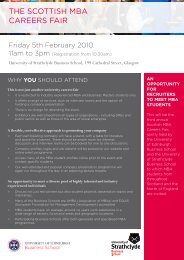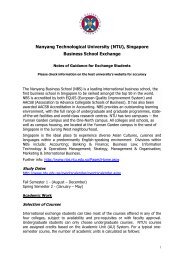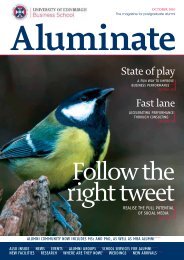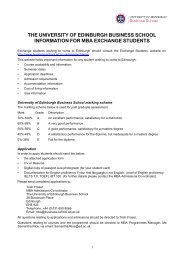killed Saab Automobile? - Business School - University of Edinburgh
killed Saab Automobile? - Business School - University of Edinburgh
killed Saab Automobile? - Business School - University of Edinburgh
You also want an ePaper? Increase the reach of your titles
YUMPU automatically turns print PDFs into web optimized ePapers that Google loves.
when it declined sharply. Unfortunately, increased volume did not bring pr<strong>of</strong>itability and in 2000 Investor<br />
AB exited, selling its 50% stake to GM for $125 million – a quarter <strong>of</strong> what GM had paid for its first 50%,<br />
10 years previously.<br />
In 2003 <strong>Saab</strong>’s engineering department was merged with GM’s European operations at Russelsheim in<br />
Germany. This meant the loss <strong>of</strong> 1,300 engineers and designers at <strong>Saab</strong> and effectively signalled the<br />
end <strong>of</strong> <strong>Saab</strong>’s ability to develop its own products (contrary to claims that would made later by Spyker,<br />
who bough <strong>Saab</strong> from GM). Sales and marketing for <strong>Saab</strong> in Europe was also integrated into GM’s<br />
operation in 2004 xviii .<br />
It was also clear that there were tensions between <strong>Saab</strong> and its parent. As the Economist was later to<br />
observe:<br />
'GM once saw <strong>Saab</strong> as a potential rival to BMW. But whereas BMWs became the default choice<br />
<strong>of</strong> striving young pr<strong>of</strong>essionals in the 1990s, buying a <strong>Saab</strong> was a statement <strong>of</strong> eccentric<br />
individualism—something utterly alien to GM’s corporate culture. GM constantly tried to force its<br />
<strong>of</strong>ten stodgily conventional engineering on <strong>Saab</strong> in an effort to save money, while <strong>Saab</strong>, just as<br />
stubbornly, attempted to preserve what was different about its cars, such as putting the ignition<br />
on the floor by the gearbox. Not surprisingly, the results pleased neither GM’s beancounters nor<br />
<strong>Saab</strong> enthusiasts.' xix<br />
BMW was not the only problem for <strong>Saab</strong>. Other German premium car brands, such as Audi, advanced<br />
steadily during the 1990s, eating into the territory that better executed <strong>Saab</strong> vehicles might have<br />
occupied. Volvo, who had been in a somewhat similar position to <strong>Saab</strong>, extended its model range and<br />
introduced high performance models such as the turbo-charged T5 that played more on ‘heart values’,<br />
enhancing its traditional image <strong>of</strong> safe-and-solid. The net effect <strong>of</strong> this was that <strong>Saab</strong> ended up in the<br />
uncomfortable position <strong>of</strong> making around 120,000 not-quite-premium cars a year. xx<br />
However, in 2005 worse was to come for the credibility <strong>of</strong> the <strong>Saab</strong> brand, in the form <strong>of</strong> the <strong>Saab</strong> 9-2X<br />
and 9-7X, both <strong>of</strong> which were sold only in the US. Lacking a smaller vehicle and an SUV in the <strong>Saab</strong><br />
range, GM succumbed to ‘badge engineering’, that is, the application <strong>of</strong> one marque’s brand to another<br />
company’s products. The 9-2X was a re-badged and lightly modified Subaru Impreza, produced in<br />
Japan. The 9-7X was a Chevrolet Trailblazer built in Ohio and sporting a very un-<strong>Saab</strong>-like eight<br />
cylinder engine. The 9-2X was quickly and disparagingly dubbed a ‘<strong>Saab</strong>aru’. xxi<br />
Crisis at GM<br />
Along with the other US car companies, Ford and Chrysler, GM enjoyed a boom period in the early<br />
2000s, driven largely by buoyant demand for pr<strong>of</strong>itable SUVs in the US domestic market. However,<br />
long-term issues such as high healthcare and pensions obligations, ailing brands and unreformed<br />
working practices remained unresolved, not to mention the continued loss <strong>of</strong> market share to the<br />
Japanese producers (albeit partially concealed by the SUV-induced boom). GM was carrying no fewer<br />
than eight brands - Chevrolet, Pontiac, Buick, Cadillac, GMC, Saturn, Hummer and <strong>Saab</strong>. Some <strong>of</strong><br />
GM’s major shareholders started applying pressure for reform, summarized in a 14-page memo in 2005<br />
which argued that:<br />
'General Motors was in a heap <strong>of</strong> trouble… but it also had enough cash to mount a turnaround<br />
effort. The key would be management’s willingness to act urgently by eliminating dozens <strong>of</strong> near-<br />
9













